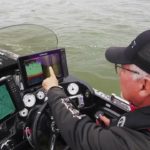Presentations, Live Bait, Safe Handling: We’re All Still Learning
 This is the time of year when I would normally write about preparing for the upcoming season. We would look at tackle maintenance, lure modification and reconditioning, planning and research, prepping the boat and motor… even physical conditioning—stretching, lifting light weights—the stuff that old-timers (e.g.: this writer) should do to stay in shape for muskie fishing. But we’ve done that a few years in a row now, so it’s hard to cover that stuff without completely repeating myself. Instead, let’s look at a topic I haven’t touched on in a while.
This is the time of year when I would normally write about preparing for the upcoming season. We would look at tackle maintenance, lure modification and reconditioning, planning and research, prepping the boat and motor… even physical conditioning—stretching, lifting light weights—the stuff that old-timers (e.g.: this writer) should do to stay in shape for muskie fishing. But we’ve done that a few years in a row now, so it’s hard to cover that stuff without completely repeating myself. Instead, let’s look at a topic I haven’t touched on in a while.
The first thing I want to mention is something I was reminded of a few weeks ago: We’re all still learning. The guy who said this to me is one of the best muskie fishermen I know. And he’s still learning. I certainly am. The so-called "experts"—the writers, the seminar speakers, the professional guides—are all still learning. If not, they’re fools, they’re in denial, or they’re both. I’ve said many times that I’ve learned something from everyone I fish with. OK, maybe what I learn from some is "what not to do," but most of my partners are great anglers, and easily teach me a lot.
At a sports show recently, I sat in on a seminar by Steve Herbeck. In a few minutes, he gave me new ideas about how to work a bait that I had used for years. His method—working a topwater Z-bait very slowly, instead of rapidly "walking-the-dog"—works for him (which gives me the confidence to try it) and promises to give me a much better hooking percentage than I had been experiencing. Five minute investment—something learned.
For the past few months, I’ve been reading (and editing) several articles by some top-notch Wisconsin muskie guides. I have always looked down my nose at any form of live bait fishing—especially for muskies. In fact I had considered it a "killing" method, because gullet and gut-hooked muskies have very little chance to survive. I still don’t think it sounds like much fun, but these guys have shown me that there are some very safe and muskie-friendly ways to fish suckers for muskies. Yes, they admit that single-hook "wait and set " rigs are indeed "kill rigs." But they have also convinced me that quickstrike rigs, used properly, are not only muskie-friendly, but cause much less damage to eyes and gills than jerkbaits and crankbaits—with their three sets of trebles. I still think live bait muskie fishing sounds less exciting than fooling a fish with an artificial, but at least they’ve taught me to stop calling them "killers."
 Still learning.
Still learning.
Another touchy subject I’m still learning about is proper handling of big fish. This is not rocket science, but there is still some controversy. Obviously, a muskie must be in the water to breath. Obviously, muskies live in an environment that supports their body and organs with a certain amount of uniform, gentle pressure. Obviously, muskies rely on the protection from parasitic critters that their body slime provides. I think we all agree on these things. But there is still debate. And there are still many who mishandle and abuse caught fish.
I’ve heard people claim that holding muskies vertically is OK. If they meant semi-vertically—with head and body supported—for only a few seconds—in a position where the fish cannot be dropped in the boat… OK, maybe. A few have said that a cradle is bad, because it removes slime. OK, it removes more slime than a clean water release. But sometimes a water release is not safe—especially for the inexperienced. It’s times like these, when the muskie must be controlled, that a cradle is the best option—far better than a fin-slicing and -dicing hoop net. A cradle removes less slime when wet. And properly used, a cradle is always in the water before the fish makes contact.
When handling muskies, we must consider personal safety, fish-handling ability and experience, and potential harm to the precious fish. It’s not cut-and-dried.
We’re all still learning.
Another thing that’s up for grabs is the direction of the whole muskie-fishing culture. Why do we fish for the rarest fish—the fish at the top of the pyramid? It certainly isn’t for immediate reward and instant gratification. If you do it enough, you know it’s a lot of work. Still, the sport is getting popular and crowded. The boats are bigger and much faster. The equipment is improving radically.
But nothing is changing as fast as the information—the knowledge that’s out there.
With all this change, I hope we can hang onto the muskie mystique that drew us to the sport in the first place.
Catch a nice one and let it go.
Let Them All Go.





